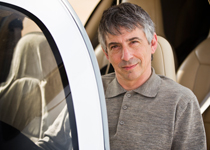Fly Well: Aching joints
You know you’re getting old when...

Subtle aging indicators—including feeling bad in the morning without having fun the night before and what doesn’t work, hurts—lead me to believe I am aging. If I were an aircraft, while I would not be museum-ready, I certainly could use an AOPA Sweepstakes makeover—specifically my feet, legs, back, elbows, and shoulders.
Always active, after a recent weight loss, I decided my informal approach to fitness was insufficient and I decided to get in shape. Now that I have the weight and energy levels of a teenager, I am experiencing the symptoms of what are charmingly called “overuse syndromes.”
Living near the Blue Ridge Mountains, beautiful hiking beckons, and the National Park Service has created fabulous trails. My feet disagree. Sauntering back to my car recently after a 13-mile hike, I experienced heel discomfort. Within a day, severe pain rendered sauntering impossible—crawling, maybe. I instantly knew this was plantar fasciitis, where ligamentous tissue binding the Achilles tendon into the heel and sole of the foot is traumatized. A function of poor arch structure, inappropriate footwear, or tight muscles, fasciitis is common; some implicate heel bone spurs, but I don’t buy that.
A doctor will easily diagnose fasciitis; upward foot stretching toward your leg is a tad painful (irony), and your heel is tender if the doctor cruelly presses it. Treatment is frustrating but includes anti-inflammatory medications; carefully selecting footwear (comfort and fashion appeal have an inverse relationship); wearing shoe inserts, preferably custom-made to your foot; special strapping to provide support; exercises to stretch tendons and ligaments; heating and then icing the troublesome area; wearing a splint at night (imagine a ski boot, only less comfortable); and maybe steroid shots.
Expect a slow recovery over many months, or even years, during which you cannot perform the precipitating exercise. Sometimes specialists recommend using external shock waves to cause tissue damage and encourage healing. I always thought that was daft, somewhat like stomping on your toe to take your mind off a bad headache, but it apparently works for some folks. In really recalcitrant cases surgery is required.
Moving up the leg, shin splints are a grim, persistent pain often in the outer reaches of the leg brought on by running or persistent walking. Leg muscles are contained within tight compartments, and either exercise-induced growth or temporary engorgement with blood stretches the walls between these compartments, causing severe pain.
Treatment is very similar to plantar fasciitis, although you must develop a different set of expletives to help deal with the discomfort. For this, and plantar fasciitis, using hiking poles when walking helps to balance forces; some believe this might reduce the risk of these two pains.
Tennis elbow refers to pain in that area and the flashier medical name, lateral epicondylitis, hints at the inflammatory process that is going on where arm muscles attach to a bony area on the elbow’s outer edge. Rarely is this induced by playing tennis; in my case it was weight lifting. Golfer’s elbow affects the medial or inner bony point. My feeble golfing efforts cause pain in my instructor’s brain and the greenkeeper’s back. Physical therapy, the same meds as above, rest in a brace; steroid injections usually help.
Frozen shoulder is a collection of problems with musculature where the arm meets the shoulder girdle. Classically presenting as the inability to raise your arm beyond a certain point without excruciating pain—which, in my case, was from taking up tennis again—together with medication and steroids, recovery involves exercises, slowly “walking” the affected hand up a wall, or using stretchy bands. Surgery is useful in some cases.
With any painful joint, one automatically adjusts gait or posture to “protect” the wounded side, which can cause secondary aches and pains such as ankle tendonitis or backache; being conscious of this risk is key. There are joints not currently on my squawk list, and I’m monitoring closely for housemaids knee and anything going awry with my left thumb.
Getting fit is important for both lifespan and health span, but I should have been more cautious—and so should you. The sad thing about experience is that by the time you have it, nobody wants it—and you know you’re getting old when you look in the mirror and say, “Dad?”
Dr. Jonathan Sackier is a British-born and trained surgeon who lives in Virginia. He is an active private pilot.
Email [email protected]


